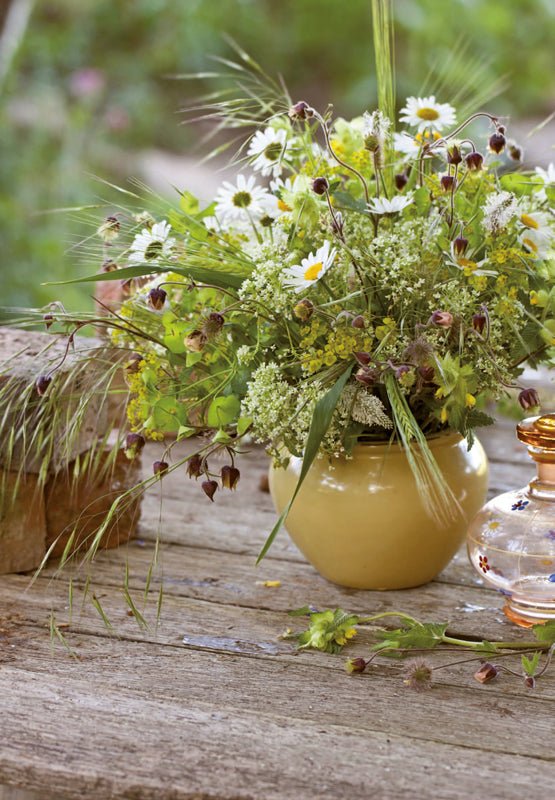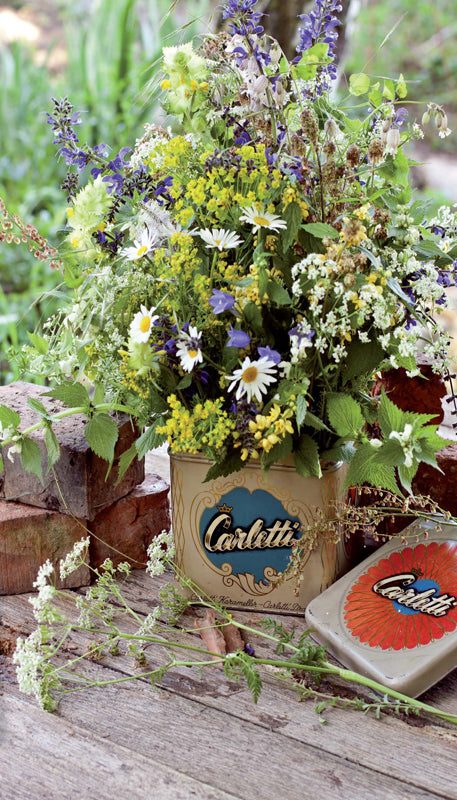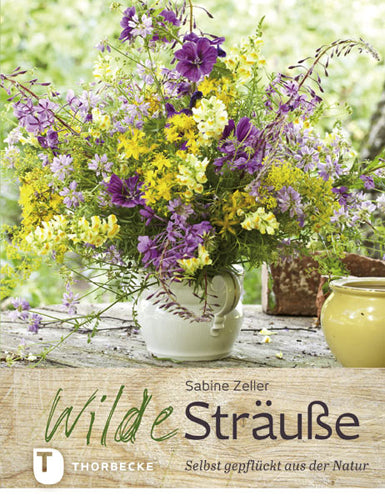Wild flower magic from nature
The sun is shining; what could be more tempting than a walk in the countryside? Why not bring nature home with you in the form of a wild ostrich?

White floral scent
Lily of the valley (Convallaria majalis), woodruff (Galium odoratum)
Who doesn't know how wonderful the lily of the valley smells? Lily of the valley was the scent our grandmother used to keep in a little bottle on her dresser. It symbolizes happiness, love, and a perfect world. So it's almost incongruous that it's actually poisonous. It can be found in partial shade, on woodland, in forest clearings, and in parks. The flower stems easily detach from their leafy stems, and a new bloom reliably sprouts from the rhizome the following year.
Woodruff, as its name suggests, is native to the forest, but also forms a reliable ground cover in the garden under tree shade. It releases its fragrance most effectively when slightly wilted. Therefore, if you plan to use woodruff in the kitchen, you should first hang it up for a day. For the famous May punch, you even harvest it before it blooms, as that's when it's most fragrant. In bloom and freshly picked, as used here, its fragrance is barely noticeable. Its delicate white petals, which complement the delicate lily of the valley, are particularly striking.

Bouquet with marsh avens
Water avens (Geum rivale), grasses, daisies (Leucanthemum), watercress (Nasturtium), ribwort plantain (Plantago lanceolata), spurge (Euphorbium)
The flower heads of the marsh valley (Geum rivale) look simple, modest, and lovely. The name "rivale" means "growing by the stream," and these delicate bells can be found anywhere humid from April to June, whether on the stream bank or in a wet meadow. The roots of the plant were once used as a substitute for cloves, hence its name. Marsh valley is also known as "blood drop," "God's bread," "heartwort," and "chimney sweep."
The delicate flowers of the marsh marigold are particularly beautiful when paired with light, delicate blossoms and leaves. Here, it's loosely combined with grasses, daisies, watercress, ribwort plantain, and spurge. If you don't tend an English lawn, you'll easily find ribwort plantain in your own meadow. Daisy plants also thrive there, if you reserve an "island" for them that won't be mowed.

Flowers from the stream meadow
Golden nettle (Lamiastrum galeobdolon), meadow sage (Salvia pratensis), common catchfly (Silene vulgaris), sorrel (Rumex acetosa), spurge (Euphorbia), burnet (Sanguisorba officinalis), bellflower (Campanula), daisy (Leucanthemum vulgare), cow parsley (Anthriscus sylvestris), white deadnettle (Lamium album), yellow rattle (Rhinantus), tin can, preserving jar
This loose bouquet was picked while walking by the stream. It wasn't tied at all, but rather placed loosely and randomly in the beautiful old tin can. Since this isn't permanently waterproof, there's still a preserving jar inside.
The plants used were golden nettle, which blooms from May to September, especially at the edge of the forest, meadow sage and dove's-foot catchfly.
Although the campion has its flowers open all day, it only smells at night. This is why it primarily attracts moths. The scent is somewhat reminiscent of clover. It blooms all summer, and in the past, soapy water was boiled from its roots. Campion keeps well in a vase.
Sorrel, spurge, and burnet were also arranged. Burnet has small, dark reddish flowers, like tiny heads. The old tin also contains bluebells, daisies, cow parsley, white deadnettle, and yellow rattle.

The content of this article is from the book:
Sabine Zeller
Wild bouquets-Picked and arranged by myself
ISBN: 978-3-7995-0523-9
Price: € 16.99 [D] / € 17.50 [A] / sfr 24.50
Thorbecke Publishing
Lush and imaginative bouquets on the table, whatever the season – you don't need a fat wallet or a luxurious garden for that. Nature gives us everything we need, even on a short walk through the local area, with our eyes open for the flowers along the roadside and in the meadow: Sometimes the focus is on a few flowers from the farmers' market, like snapdragons or gladiolas, with which apparent weeds form a wonderful bouquet; sometimes it's unripe blackberries, dried thistles, ears of grain, or the decorative fruit clusters of clematis that give a bouquet or wreath that certain something.
For each month, several bouquets are shown with atmospheric, full-page photos. For each bouquet, the plants used are presented in a separate image and explained where to find them and how to care for them.






























































































